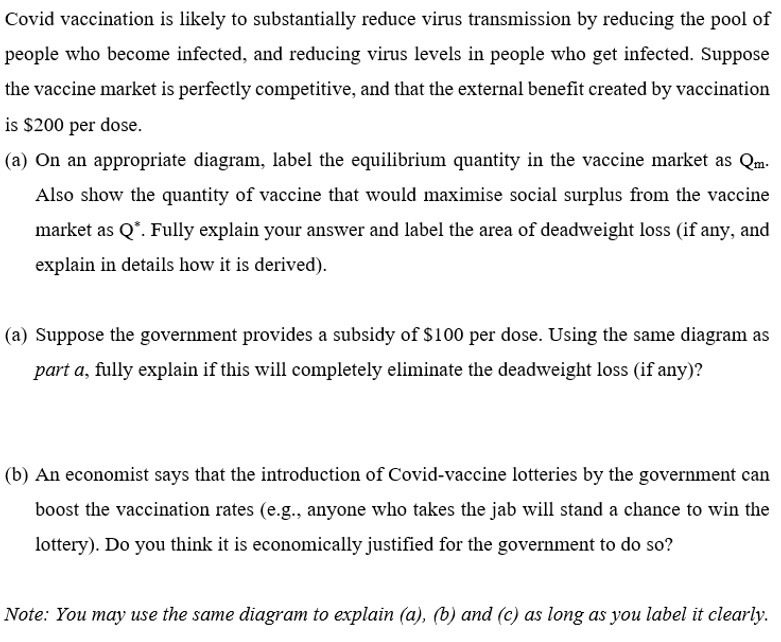Covid vaccination is likely to substantially reduce virus transmission by reducing the pool of people who become infected, and reducing virus levels in people who get infected. Suppose the vaccine market is perfectly competitive, and that the external benefit created by vaccination is $200 per dose. (a) On an appropriate diagram, label the equilibrium quantity in the vaccine market as Qm. Also show the quantity of vaccine that would maximise social surplus from the vaccine market as Q*. Fully explain your answer and label the area of deadweight loss (if any, and explain in details how it is derived). (a) Suppose the government provides a subsidy of $100 per dose. Using the same diagram as part a, fully explain if this will completely eliminate the deadweight loss (if any)? (b) An economist says that the introduction of Covid-vaccine lotteries by the government can boost the vaccination rates (e.g., anyone who takes the jab will stand a chance to win the lottery). Do you think it is economically justified for the government to do so?
Covid vaccination is likely to substantially reduce virus transmission by reducing the pool of people who become infected, and reducing virus levels in people who get infected. Suppose the vaccine market is perfectly competitive, and that the external benefit created by vaccination is $200 per dose. (a) On an appropriate diagram, label the equilibrium quantity in the vaccine market as Qm. Also show the quantity of vaccine that would maximise social surplus from the vaccine market as Q*. Fully explain your answer and label the area of deadweight loss (if any, and explain in details how it is derived). (a) Suppose the government provides a subsidy of $100 per dose. Using the same diagram as part a, fully explain if this will completely eliminate the deadweight loss (if any)? (b) An economist says that the introduction of Covid-vaccine lotteries by the government can boost the vaccination rates (e.g., anyone who takes the jab will stand a chance to win the lottery). Do you think it is economically justified for the government to do so?
Chapter19: Externalities And Public Goods
Section: Chapter Questions
Problem 19.7P
Related questions
Question
Need answer for this ..

Transcribed Image Text:Covid vaccination is likely to substantially reduce virus transmission by reducing the pool of
people who become infected, and reducing virus levels in people who get infected. Suppose
the vaccine market is perfectly competitive, and that the external benefit created by vaccination
is $200 per dose.
(a) On an appropriate diagram, label the equilibrium quantity in the vaccine market as Qm.
Also show the quantity of vaccine that would maximise social surplus from the vaccine
market as Q*. Fully explain your answer and label the area of deadweight loss (if any, and
explain in details how it is derived).
(a) Suppose the government provides a subsidy of $100 per dose. Using the same diagram as
part a, fully explain if this will completely eliminate the deadweight loss (if any)?
(b) An economist says that the introduction of Covid-vaccine lotteries by the government can
boost the vaccination rates (e.g., anyone who takes the jab will stand a chance to win the
lottery). Do you think it is economically justified for the government to do so?
Note: You may use the same diagram to explain (a), (b) and (c) as long as you label it clearly.
Expert Solution
This question has been solved!
Explore an expertly crafted, step-by-step solution for a thorough understanding of key concepts.
This is a popular solution!
Trending now
This is a popular solution!
Step by step
Solved in 3 steps with 1 images

Knowledge Booster
Learn more about
Need a deep-dive on the concept behind this application? Look no further. Learn more about this topic, economics and related others by exploring similar questions and additional content below.Recommended textbooks for you








Managerial Economics: A Problem Solving Approach
Economics
ISBN:
9781337106665
Author:
Luke M. Froeb, Brian T. McCann, Michael R. Ward, Mike Shor
Publisher:
Cengage Learning
